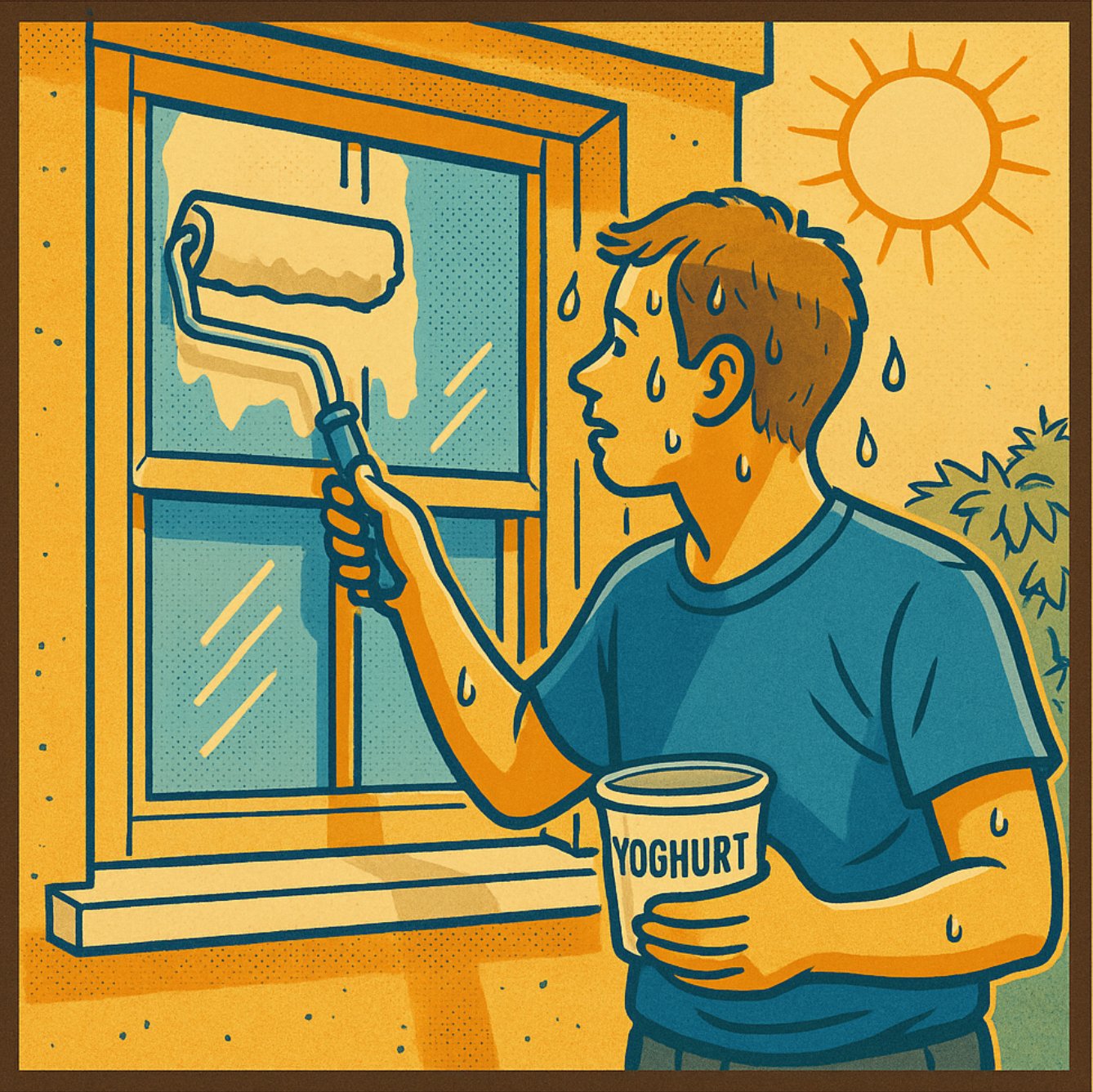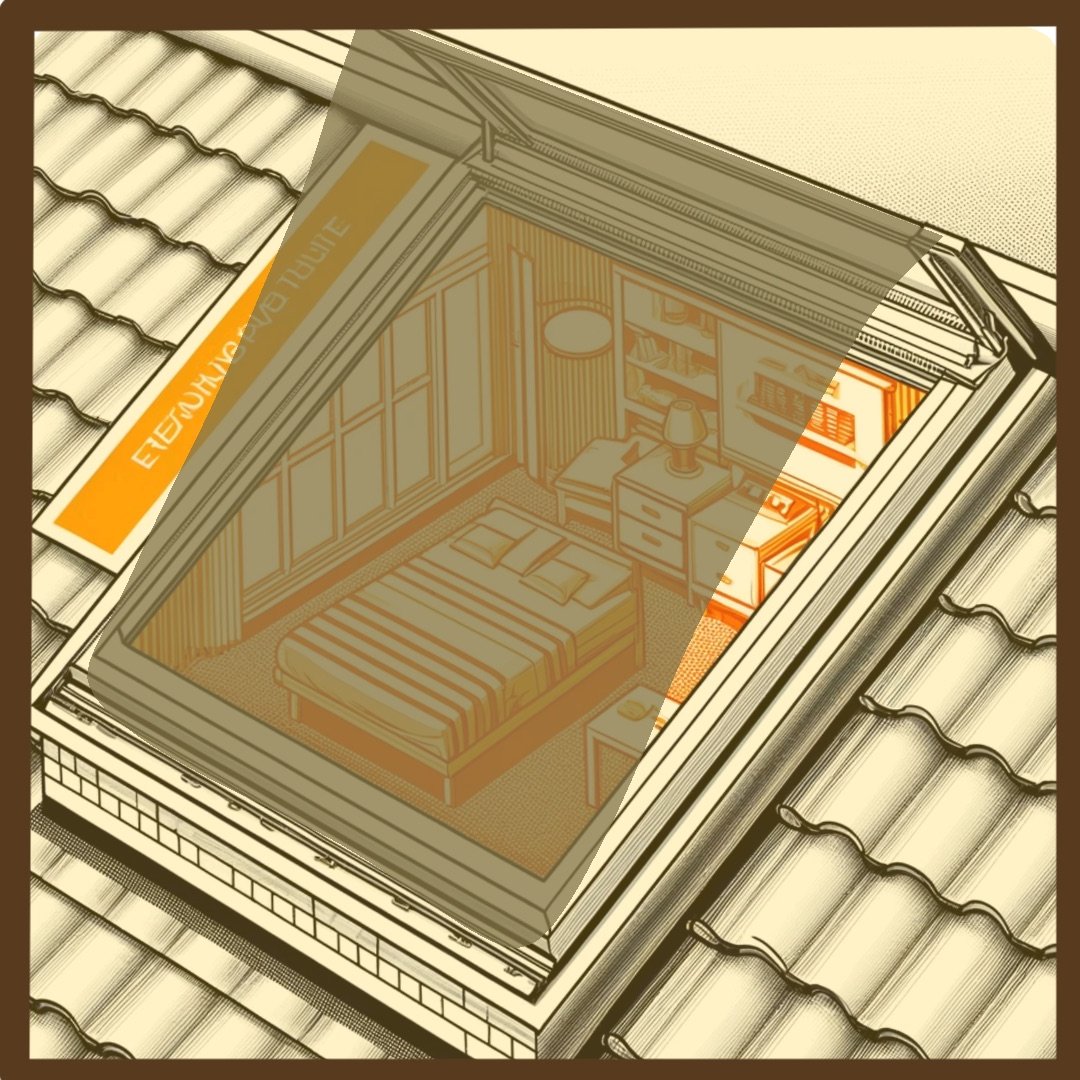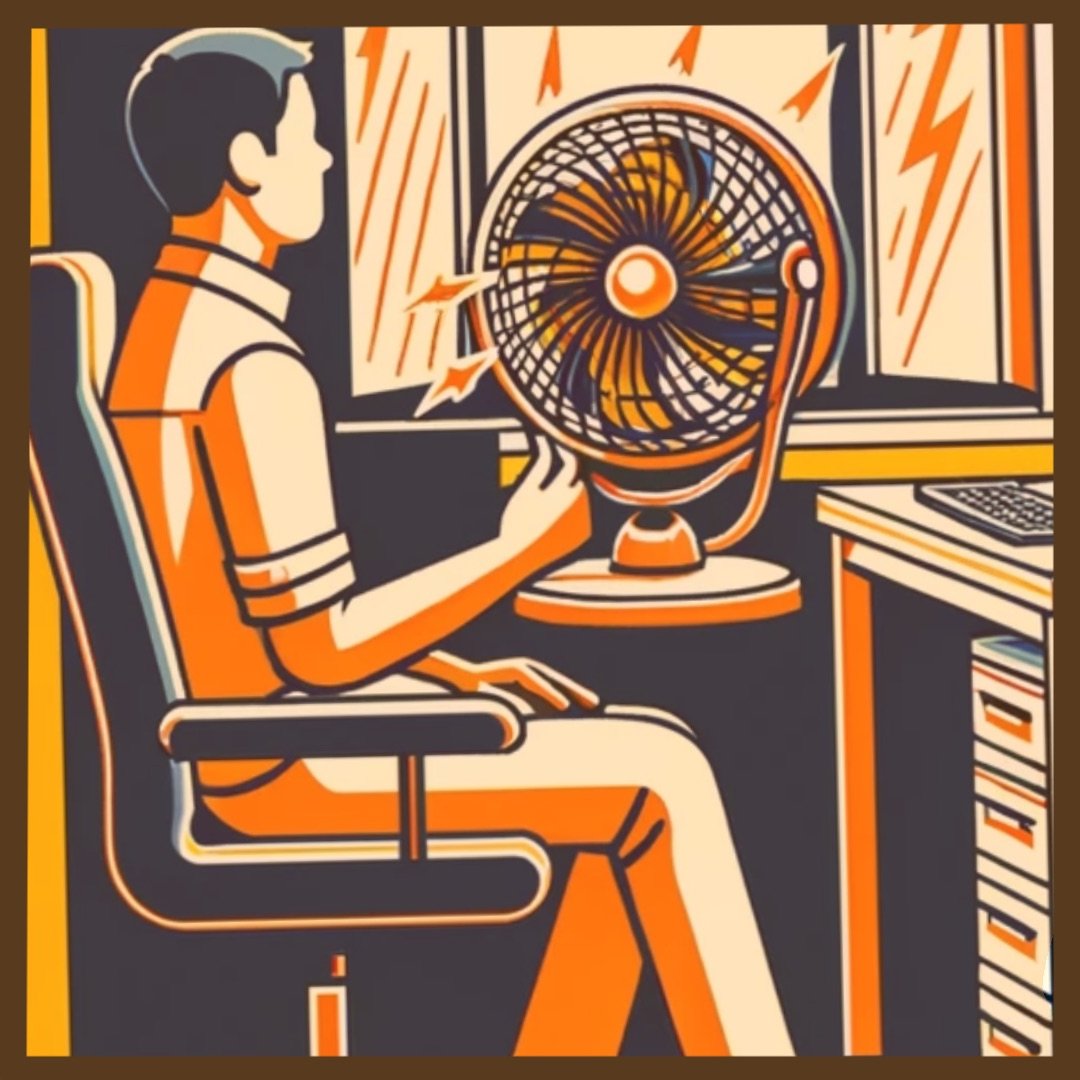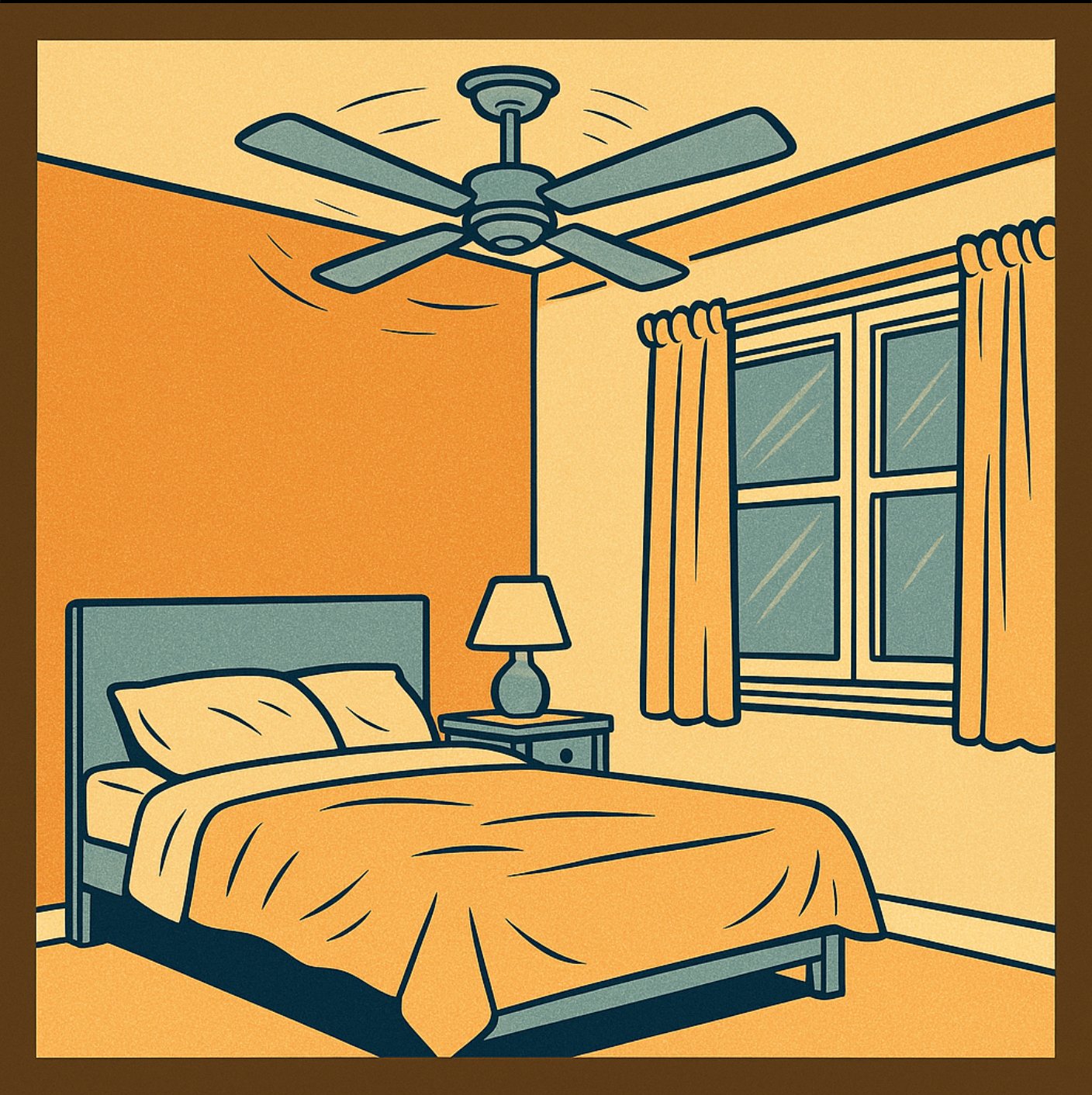Solutions
This page shares low-cost, low-effort and rapidly deployable ways to stay cool at home during heatwaves. Many are DIY-friendly, can be delivered tomorrow and suitable even in rented homes.
We’ve grouped the ideas under Stop / Flow / Slow and ranked them by capital cost.
Every home is different - do seek professional help, advice and permissions where relevant - take what fits and share with a neighbour.
Sleep better, feel better, stay productive.
Stop the Sun
Shade windows and rooflights from the outside - it’s far more effective. Shade them however you can!
| Stop the Sun | Effort | Cost | Impact | Value for Money |
|---|---|---|---|---|
| Close your Blinds and Curtains | e | £ | * | Low |
| Shade Your Windows with a Temporary Covering | ee | £ | **** | V High |
| Paint Yoghurt on your Windows | eee | £ | *** | High |
| Use Shade Cloth | eee | ££ | **** | High |
| Use A Solar Screen | eee | ££ | **** | High |
| Set up a Camouflage Net | eee | ££ | **** | High |
| Rig up a Solar Sail | eee | ££ | **** | High | Stick a Reflective Film to Your Windows | eeee | ££ | ** | Low |
| Add External Solar Shading to your Velux Roof Window | eee | £££ | **** | Med |
| Paint Your Roof White | eeee | ££ | ** | Low |
| Use a Half Parasol | ee | £££ | **** | Med |
| Install A Manual Awning | eeee | ££££ | **** | Low |
£ = 0-£10 ££ = £10-£50, £££ = 50-100, ££££ = 100+
Close your Blinds and Curtains
If the sun is beaming through your windows, closing internal blinds and curtains will reduce solar gains. While this is easy to do, the impact will be minor. Closing internal blinds or curtains still lets the heat get through the glass, and will only reduce solar gains by about 10%.
To make a significant impact, shade the windows from the outside. Even a rudimentary covering on the outside of a window can stop 100% of solar gain - far more effective.
More information on the Blog Post Why does solar shading need to be external? Won’t closing curtains do?
Shade Your Windows with a Temporary Covering
Is the sun beaming through your windows? Shade them from the outside. This will prevent heat from direct sun from entering the property and is far more effective than just closing internal blinds or curtains.
Europeans regularly employ products such as external roller shutter blinds and awnings, but these are currently much less common in the UK. The same effect can be achieved with less intervention on a more temporary basis.
Cover windows and roof lights with old towels, curtains, bed sheets or bamboo screening to shade glazing. These are temporary but very effective measures - give it a try before you invest in something properly designed for the job!
Perforated materials work best because they preserve a view out. For example, perforated paper packaging materials could be taped to the outside of the glass to block out the heat but preserve a view, and then recycled when no longer required. Mesh fabric could be applied to the exterior of the glazing and washed from time-to-time.
A less temporary solution would be to adapt Velux’s anti-heat awning product, a mesh fabric which rolls up, and is sold as a solution for a roof window but can sometimes be fixed above a normal window with the help of a handyman.
More discussion on these blog posts: Stick Perforated Material to Your Glazing & Install External Shading on your Roof Windows
| Inventory - Paper Mesh |
|---|
| White Honeycomb Paper Packaging* |
| Black Honeycomb Paper Packaging* |
| Black Honeycomb Paper Packaging* |
| Tape* |
| Inventory - Anti-Heat Blind |
|---|
| Velux Anti-Heat Awning Blind* |
Paint Yoghurt on Your Windows
Is the sun beaming through your windows? Paint a temporary coating on the external surface of the glazing. This will reflect some heat from the direct sun entering the property while still allowing light through, and it will be ready to be washed away when not needed.
Here's a paint-on glazing coating product marketed for cooling greenhouses*, but what’s cheaper, more readily available and works even better? Yoghurt! And what’s a lower-carbon version? Oat yoghurt!
Apply with a gloss paint roller and reach first-floor windows with a telescopic pole. Use masking tape to leave a few eye-level gaps to maintain a view.
Once the heatwave is over, wipe it clean. It comes off easily with a touch of soap. Do it yourself, or invite your regular window cleaner over!
It works, it’s low-cost and it’s quick to apply to glazing. It’s been covered by The BBC, Dezeen. And no, it doesn’t smell or attract insects.
For more discussion on this, check out this blog post - Paint Yoghurt on your Windows
| Inventory |
|---|
| Oat Yoghurt* |
| Gloss Paint Roller* |
| Telescopic Pole* |
| Masking Tape* |
| Window Scrubber & Squeegee* |
Use Shade Cloth
Are your windows exposed to the hot summer sun?
Try using shade cloth. This material is commonly used by farmers and gardeners in the USA to keep their plants alive and productive in hot summer months. The mesh fabric comes in different densities and on bright days enables a view out.
One packet goes a long way. Cut it to size with scissors and stretch it across the outside of your sun-exposed windows and rooflights and you’ll feel the benefits straightaway!
In the USA, it’s available in a range of colours, but in the UK, only the black version appears to be readily available.
| Inventory |
|---|
| Shade Cloth* |
| Zip Ties* |
Set up a Camouflage Net
Does the sun blast into your home?
Try providing some shading with a camouflage net. It will block out a good proportion of the direct sun (and its heat) whilst still offering you plenty of view, daylight and ventilation.
When the weather warms up, set it up, cut it to size with sharp scissors, and rig it up with zip ties. Drape it over windows or rooflights, or use it to form a make-shift awning or pergola. Available in lots of different sizes and colours.
Stick it in a washing net and clean it gently in autumn so it’s ready for next year.
Want more shading from your camouflage net? Double the net over and it’ll block out more of the sunshine!
| Inventory |
|---|
| Camouflage Net - White* |
| Camouflage Net - Black* |
| Zip Ties* |
Rig up a Solar Sail
Got lots of glazing where the sun beams in?
How about a solar sail to shade the glazing? They come in triangular and square shapes and in lots of sizes.
Rig it up when the sun is blaring and take it down in between hot spells and when the wind picks up! Get a friendly builder to install some stainless steel eyelets and grab some karabiners.
| Inventory |
|---|
| Solar Sail* |
| Karabiners* |
Stick a Reflective Film to Your Windows
Many aftermarket film products are available to apply to the outside of your glazing. These will work to reduce solar gain. But they’re not recommended.
Window films are difficult to apply without causing creases and challenging to remove once autumn arrives. And when you’re done with them after a heatwave, the films won’t likely be reusable or recyclable.
Don’t leave them on all year round - that’ll reduce the heating benefits of the winter sun and will diminish the available daylight in your home too.
Consider shading your windows with a temporary covering instead - lower cost and far more effective.
Use a Solar Screen
A solar screen is a mesh fabric—usually made from glass-reinforced fibres—stretched tightly in an aluminium frame and clipped over sun-facing windows. It’s a bit like an insect screen, but instead of keeping bugs out, it reflects and absorbs solar heat before it hits the glass. These are commonly used in hot parts of the USA to reduce air conditioning bills, and you can find kits in hardware stores there like Home Depot.
I first noticed them on houses in the southern US and assumed they were insect screens—turns out they’re doing a lot more work than that.
The idea is simple: make them to size, clip them onto the outside of your sunny windows, and take them down again once the heatwave has passed.
French manufacturer Saint-Gobain makes high-performance solar screen fabrics, though they don’t yet seem to be widely available in the UK. Here’s a link to one of their datasheets.
Know of a UK stockist? Please get in touch!
Add External Solar Shading to your Velux Roof Window
Got a Velux roof window? Does sun blast through it during the day? Due to their orientation, this will likely be a major source of heat.
The Velux Anti-Heat Awning Blinds are fantastic external blinds products, and they can be installed as a DIY project as long as the roof light is within reach.
They hide away in a pocket when they’re not needed. They reflect 78% of the heat from the window from direct sunlight, whereas an internal equivalent would reflect just 5%.
There’s a more robust alternative, the Velux Anti-Heat Blackout Blind. They can provide blackout, are even more effective at keeping the heat out, and can be operated by remote control. They reflect up to 90% reduction of heat.
These products are brilliant. I’ve even installed them above vertical windows as pull-down external blinds.
Head to this blog post for a case study- Install External Shading on our Roof Windows
| Inventory |
|---|
| Velux Anti-Heat Awning Blind - Manual* |
| Velux Anti-Heat Awning Blind - Remote Controlled* |
Use Bamboo External Shading
External bamboo blinds are an affordable and fast option—you can often get them delivered within a week. They roll up and down easily, blocking most sunlight while still letting a little dappled light through.
The main challenge is fixing them securely to the outside of your window or wall. But once they’re up, they’re simple to use, and you can roll them away and store them after the heatwave has passed-ready for next time.
If these suit your space, you might also consider upgrading to a more durable external blind system-there are some excellent UK-stocked options out there, like these from The Green Blind (BBSA Members)
| Inventory |
|---|
| Bamboo External Blind* |
| Timber Blinds by The Green Blinds |
Paint Your Roof White
Have you got a dark-coloured roof? Paint it white! It'll reflect the sun and less heat will enter the home.
| Inventory |
|---|
| Roof Paint* |
Use a Half-Parasol
Half parasols are exactly what they sound like-parasol canopies with a flat back so they sit flush against a wall. That makes them ideal for shading windows on hot days.
Just raise one up in front of sun-facing glazing to block direct sunlight and reduce overheating indoors. They’re quick to open, easy to adjust, and many come with semi-circular bases so you can position them snugly against walls or windows.
A neat, flexible solution-especially for renters or anyone wanting shade without drilling into walls.
| Inventory |
|---|
| Half Parasol* |
| Half Parasol Base* |
Install a Manual Awning
Retractable awnings can get pricey-especially with motorised openers, wind sensors, and fancy fabrics. But a manually operated version can offer the same essential benefit—shading your windows and walls-for a fraction of the cost (and a bit of a workout too).
These need a bit more DIY confidence to install than some of the other ideas here, but in the right spot-especially over south- or west-facing windows—they can make a big difference to indoor temperatures.
Just don’t forget to wind them back in when the wind picks up!
| Inventory |
|---|
| Manual Awning* |
More Permanent Solutions
Are you looking for something more permanent, more holistic or more robust?
If you’ve got the agency to make more significant changes to your home and the space around it, excellent guidance already exists to help optimise your UK home's summertime performance.
Perhaps you’ve got plans to refurbish your home, add an extension, develop the landscaping or build a new home entirely. In these cases, this is likely the most cost-effective time for you to consider the benefits of integrating external shading and systems like whole-house mechanical ventilation systems with summer bypass modes. Make sure you and your builder and architect, if you’re using one, are aware of your ambition and point them towards the following.
Start with Good Homes Alliance’s guidance for Overheating in New and Retrofit and Existing Homes. It’s all excellent. Then, consider their Design Guidance for Shading. You’ll likely need to consider Part O of the Building Regulations if it's a brand-new home. To get the full benefit from this, employ an environmental designer to help you compare different options and ideas.
The British Blinds and Shutter Association is an excellent resource for providers of a whole range of shading products. One of their members, The Green Blind, suppliers DIY products, higher grade than others shown on this website.
2. Let Cool Air Flow
| Stop the Sun | Effort | Cost | Impact | Value for Money |
|---|---|---|---|---|
| Open and Close Your Windows At The Right Time | e | £ | *** | High |
| Get a Desk Fan | ee | ££ | ** | Medium |
| Install a Ceiling Fan | eeee | ££ | ** | Medium |
| Drive in Cool Night Time Air | ee | £ | *** | High |
| Install MVHR | eeee | ££££ | ** | Low |
| Buy Air- Conditioning | eeee | ££££ | **** | Low |
£ = 0-£10 ££ = £10-£50, £££ = 50-100, ££££ = 100+
Open and Close Your Windows at the Right Time
Open the windows - but only when it's cooler outside than in. Don’t let the heat in! As soon as things hot up outside, and it’s hotter outside than inside, shut those windows!
In a heatwave, it can be hard to get the timing right. Buy a pair of thermometers, keep one inside and the other outside (in the shade) and keep the heat out!
And if you’ve got mechanical ventilation systems installed, set them to boost and summer bypass as relevant!
| Inventory |
|---|
| Pair of Thermometers* |
Get a Desk Fan
The increased airflow over your skin helps your skin sweat more effectively, cooling you down. You can buy expensive ones, but that won’t necessarily help - it's just about getting airflow over your skin and a basic one will do just fine.
Watch out: switch the fan off at air temperatures of 35 degrees or more as the fan will likely heat you up rather than cool you down! Get a thermometer so you’re aware of the room temperature.
| Inventory |
|---|
| Desk Fan* |
| Thermometer* |
Drive in Cool Night Time Air
Night time external air temperatures are low. Position fans so they drive in cool air.
| Inventory |
|---|
| Desk Fan* |
| Thermometer* |
Install a Ceiling Fan
The Europeans use ceiling fans all the time - low running costs and plenty of comfort!
Here are some great-looking ceiling fans available in the UK that a friendly electrician can install.
Particularly good for above the bed to help you sleep at night!
Watch out: switch the fan off at air temperatures of 35 degrees or more, as it will likely heat you rather than cool you down! Get a thermometer so you’re aware of the room temperature.
| Inventory |
|---|
| Ceiling Fan* |
| Thermometer* |
Install MVHR with Summer Bypass
There are many good reasons to install whole-house MVHR (Mechanical Ventilation with Heat Recovery). It’s a mechanical ventilation system for your home. One of these good reasons is the summer bypass function. The system automatically pumps in cool outdoor air into the home even when the doors and windows are closed tight.
If you’ve got MVHR already, make sure you read the manual and get the best out of the summer bypass setting.
And if you haven’t ask your builder to plan and install it when you are undergoing renovation works at home. It can get pricey but you won’t look back!
Buy Air-Conditioning
Many will get through UK heatwaves with the use of small portable cooling units.
Unfortunately, mechanical cooling comes with significant drawbacks of energy costs, usage of planet-warming refrigerants and will contribute to the urban heat island effect.
Note that employing the other measures described above in combination with air-conditioning will benefit the effectiveness of a mechanical cooling system as well as reduce its energy usage.
Also, note that air conditioning won’t operate in a power cut and makes noise. Less temporary systems will likely need a planning application, breakdown and will require regular maintenance.
3. Slow down - change your pace
| Solution - Control Air Flow | Effort | Cost | Impact | Value for Money |
|---|---|---|---|---|
| Use Less Energy | e | £ | ** | Med |
| Drink Water | e | £ | ** | Med |
| Choose the Best Time to Leave the House | ee | £ | ** | Med |
| Take a Cool Shower | e | £ | ** | Med |
| Use a Cold Flannel | ee | £ | * | Low |
£ = 0-£10 ££ = £10-£50, £££ = 50-100, ££££ = 100+
Use Less Energy
Try to keep your energy usage low during a heat wave - all electricity and gas usage will end up as heat in your home.
Use LED bulbs, cook with a microwave instead of a regular oven, and use your smart meter to confirm that your electricity usage is low.
Drink Water
Drink cool drinks and keep hydrated.
In hot weather, sweating cools you down. The fluid you lose through sweat needs replacing - so drink up!
Choose the Best Time to Leave The House
Not everyone can leave home. But if you can, avoid being outside during the peak heat of the day, stick to the shade, and exercise only in the early morning or evening when it’s coolest.
Wear sunscreen - sunburn will make your skin feel hotter.
Carry an umbrella or parasol to protect you from the sun.
Visit air-conditioned spaces if you can
| Inventory |
|---|
| Parasol* |
Take a Cool Shower
A cool shower or bath will directly cool your body and give you relief from the heat.
Water is a scarce resource, and many shower heads provide a disappointing shower experience while having a high flow rate. Try a good low-flow shower like those made by Methven — it'll likely improve your shower while lowering your water usage, too.
| Inventory |
|---|
| Low Flow Shower Handset* |
| Low Flow Fixed Shower Head* |
Use a Cold Flannel
Hot-headed? Wet a flannel with cool water and place it on your forehead.
It'll cool your skin by simulating sweating.
Did you know? The older you get, the less effective your sweat glands become.
| Inventory |
|---|
| Flannel* |
What have we missed?
What are we missing?
Know of some good, DIY solutions that we’re missing?
Please let us know!




























